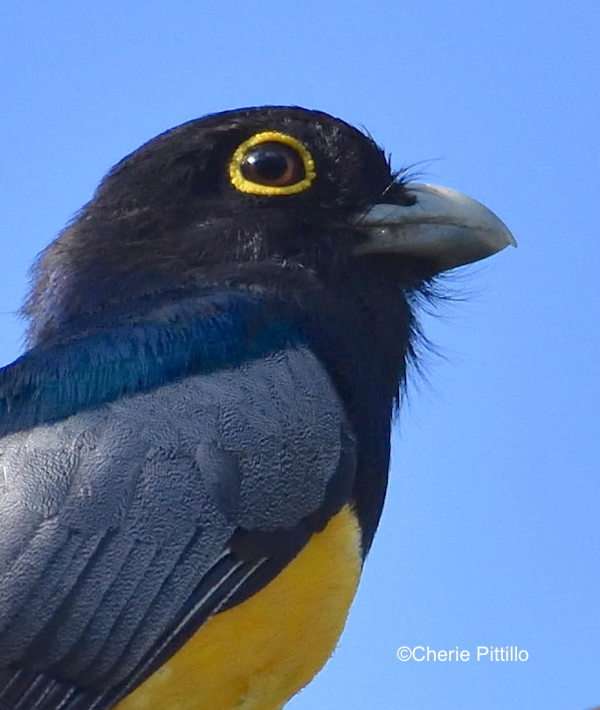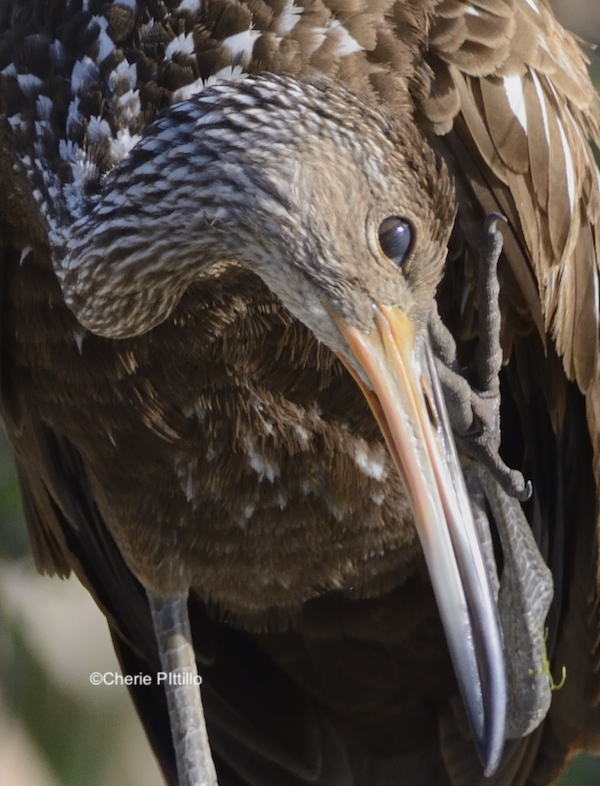That something as insignificant as an eyelid had its place in the workings on the universe, that the cosmic order did not overlook this momentary fact.
Haruki Murakami

I’d just photographed Purple Gallinule courtship* from a boardwalk when a Double-crested Cormorant landed atop the railing about eight feet from me at this freshwater wetland. Hmmm, has this bird been hand-raised? It obviously wasn’t afraid. At that moment I was glad for a small zoom lens which could focus in that short distance unlike my larger lenses. I concentrated on a few shots of its head with those teal eyes and then skirted away.
When I reviewed my images, I couldn’t believe those colorful eyelids.Those photo prompts inspired me to learn more. Were those eyelids actually an exterior part of the interior sclera ring, the bony structure supporting the eyeball? Diagrams looked misleading. Perhaps they were just called eye-rings, field marks that can help identify a species because many times the eye-rings look like eyelids. And sometimes the eyelids are called orbital rings. But orbital rings/eyelids are made of skin and eye-rings are made of tiny feathers. Then I began many hours of almost fruitless research, and trust me, this is an eye-opener!
EYELIDS
All birds have upper and lower eyelids made of folds of skin. (Have you ever thought of a bird’s eyelids? I hadn’t and apparently neither have many researchers. Bird studies seem to concentrate on vision and the inner parts of the eye, eye color, and primarily the “third eyelid.” But I did find a little info on an American Dipper, a grayish bird with a white eyelid. That’s about all. But I still have questions!)
Most birds active during the day have lower lids that come up higher than the upper lid. Surprise!

However, nocturnal species, like owls and the group of nightjars like nighthawks and Whip-poor-Wills have a larger movable upper lid than lower eyelid along with parrots, toucans, wrens, and ostriches. For example, owls’ eyes face forward on their heads and blink like we do by closing their UPPER eyelids. I would call them “eyedroppers.” But for sleeping, they use both.


Then there’s the potoo, also in the nightjar family, with bark-like plumage, which camouflages itself against a tree or snag during the daytime. Depending on the reference, it has two or three slits in its closed eyelid to see threats so the bird can maintain camouflage but still escape by flight if necessary during its daytime snooze. (More conflicting info in the references.)

With the Double-crested Cormorant the eyelid colors of adults differ from bright blue to light blue or yellow or orange depending on location or even the individual. I knew the mouth of an adult turned blue during the breeding season and the male opens his mouth to show his mate during courtship. This aids in pair bonding. So I wondered if the mouth coloring pigment impacts those blue dots of the eye. What I finally learned about birds’ eyelids were the lacking of scientific studies which could change dependent on geographic location or the season or the age plus inconsistency among individuals. No wonder I had such a time finding information!

I have eyewitnessed that some juvenile birds may have different colors from adults as if the adults were wearing eyeliners. Like the information on the cormorant, I’ve observed enhanced eyelid color during breeding season which I infer as a sexual attractant and maybe simply aid in individual or mate recognition. Some eyelids appear different between sexes too. Here are a few of my examples:











In all birds, mammals, and some reptiles and amphibians, eyelids close the eyes. However, only at a bird’s death will the lids close automatically according to one source. Perhaps that’s where “deadeye” originated.
THIRD EYELID
In addition research indicates a “third eyelid,” the nictitating membrane, which is a vertical fold under the eyelids usually located near the corner of eye at bill. It can be clear or whitish/bluish when translucent; some birds use all “three eyelids” at the same time. Most only use this membrane without the eyelids to sweep across the eye to clean, protect and moisten it using many brush-tipped cells that lubricate with tears.


You’ve probably seen this thin membrane on your cat or dog’s eyes. Nictitating simply refers to blinking.
Functional examples of this inner eyelid help as:
▪ a windscreen while flying or diving for prey from the air
▪ goggles during an underwater chase or flying among trees or shrubs
▪ protection from exuberant chicks receiving food from a parent
▪ protection from parent receiving nest material
▪ a safeguard during aggressive encounters




Practically every article and ornithology book I read stated this membrane moves horizontally across the eye. My images show it moves vertically or sometimes diagonally except for one tropical species, a motmot, photographed below. So I don’t understand their meaning of horizontally. Also most stated it is clear or translucent but not both.

Stayed tuned next month for an “eye-dea” I have about
colorful eyelids and more details about eye-rings. You’ll get an eyeful.
SPECIES MENTIONED IN PART 1
Gartered Trogon, Trogon caligatus, Coa Violácea Norteña (Spanish) Ku’us (Mayan)
Double-crested Cormorant, Phalacrocorax auritus, Cormorán Orejón (Spanish), Mach (Mayan)
Burrowing Owl, Athene cunicularia, Tecolote Llanero (Spanish)
White-fronted Parrot, Amazona albifrons, Loro Frente Blanca (Spanish), Sak pool xt’uut (Mayan)
Great Potoo, Nyctibius grandis, Biemparado Grande (Spanish)
Killdeer, Charadrius vociferus, Chorlo Tildío
Least Grebe, Tachybaptus dominicus, Zambullidor Menor (Spanish), Xpatux já (Mayan)
Baltimore Oriole, Icterus galbula, Calandria de Baltimore (Spanish), Yuya, Yuyum (Mayan)
Red-winged Blackbird, Agelaius phoeniceus, Tordo Sargento (Spanish), Chuleeb (Mayan)
Cattle Egret, Bubulcus ibis, Garza Ganadera (Spanish)
Great Egret, Ardea alba, Garza Blanca (Spanish), Sak najoch bok (Mayan)
Snowy Egret, Egretta thula, Garza Dedos Dorados (Spanish), Ka’an ook (Mayan)
Great Blue Heron, Ardea herodias, Garza Morena
Limpkin, Aramus guarauna, Carrao (Spanish), Korrea (Mayan)
Anhinga, Anhinga anhinga, Anhinga Americana (Spanish), Chowak kaal (Mayan)
Little Blue Heron, Egretta caerulea, Garza Azul (Spanish)
Lesson’s Motmot, Momotus lessonii, Momoto Corona Negra o Tooj de Monte (Spanish), Jut jut (Mayan)
ENJOY AN EYEFUL OF NATURE’S MAGNIFICENCE!
DISCLAIMER: References do not agree about this information.
The Handbook of Bird Biology, Sal a Pajarear Yucatán, Bird & Reserves of the Yucatan Peninsula, A Guide to the Birds of Mexico and North Central America, A Dictionary of Birds, The Sibley Guide to Birds, A Guide to the Birds of Costa Rica, Ornithology in Laboratory and Field, Owls of the World, pg 42, The Life of Birds, The Wonder of Birds
https://www.birdwatchingdaily.com/birds/david-sibleys-id-toolkit/david-sibley-explains-eye-rings/
https://birdsoftheworld.org/bow/species/doccor/cur/appearance
http://people.eku.edu/ritchisong/birdbrain2.html
https://www.karger.com/Article/Abstract/46499
https://www.florida-ecology.com/nictitating-membranes
http://www.hiltonpond.org/ThisWeek030422.html
https://academic.oup.com/iob/article/2/1/obaa048/6064152
https://birdsofseabrook.app.clemson.edu/taxa/t082-caprimulgids.html
https://www.audubon.org/news/birds-have-built-goggles
https://journeynorth.org/tm/spring/OwlFacts.html
https://archives.evergreen.edu/webpages/curricular/2011-2012/m2o1112/web/birds.htm
https://www.azquotes.com/quotes/topics/eyelids.html?p=2
Cherie Pittillo, “nature inspired,” photographer and author, explores nature everywhere she goes. She’s identified 56 bird species in her Merida, Yucatan backyard view. Her monthly column features anecdotes about birding in Merida, Yucatan and also wildlife beyond the Yucatan.
Contact: [email protected] All rights reserved, ©Cherie Pittillo
